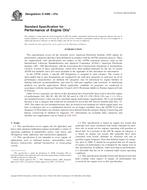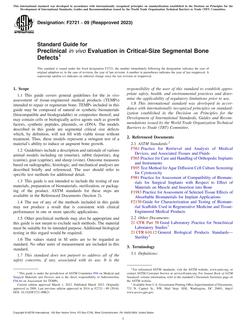1.1 This guide establishes the basic sensor data format requirements for Unmanned Undersea Vehicles (UUVs). This guide is intended to influence the development process for the acquisition and integration of various sensor packages, but at the same time, not specify particular solutions or products. An additional intent of this guide is to address the data format standards specifically required for operation of the U.S. Navy’s planned 21-in. Mission Reconfigurable UUV System (MRUUVS), which is representative of its heavy weight class of UUVs. Although this initial release of UUV sensor data formats standards primarily focuses on the U.S. Navy’s UUV missions comprising intelligence, surveillance and reconnaissance (ISR), mine countermeasures (MCM), and oceanographic data collection, there is broad utility across the spectrum of commercial applications as well.
1.2 Readers of this guide will find utility in referencing Guides F 2541, F 2594, and WK11283. There is a clear relationship that exists in terms of data formats, external interfaces, and information/data exchange that can be applied in context with the standards invoked in these documents.
1.3 The main body of this guide, Section , provides general guidelines for sensor data, including water column and ocean bottom undersea search and survey (USS) measurements, and above-waterline data. It describes required records, but does not attempt to specify individual record formats, except as already established in existing documentation. Whenever possible, data formats are suggested to conform to existing convention to facilitate data processing and use. This guide generally notes where standard U.S. Department of Defense (DoD) formats are established or de facto commercial formats exist and are adequate, such as widely accepted World Meteorological Organization (WMO) or Intergovernmental Oceanographic Commission (IOC) standards.
1.4 Though the general guidelines established in this guide apply to most oceanographic sensor data, the data types specifically considered here are limited to: water column measurements (including temperature, salinity, currents, optical clarity, and bioluminescence), ocean bottom measurements (including bathymetry, acoustic images, and sub-bottom), ambient noise, and related geophysical parameters. Specific above-waterline ISR sensor data is addressed by reference to governing U.S. military standards for certain data types. Discussion of electromagnetic and electro-optical (EM/EO) data formats (including atmospheric refractivity) is also included.
1.5 Section covers related mission data formats such as timing. It also serves as a placeholder for future discussion of vehicle-specific mission data formats. Navigation, vehicle status, and related vehicle information data formats are expected to be addressed in subsequent versions of this guide. Also included in this section are brief discussions on external interface and command and control formats. Section introduces the topic of metadata formats. Amplification of this subject is warranted and will be incorporated into future versions of the guide. Section briefly identifies general data storage media concerns for UUVs, but does not attempt to mandate decisions best made by system developers based on mission needs. Onboard data storage decisions will be driven by power requirements, data volume, and media cost. Section presents an abbreviated summary of the currently recommended data format standards where they could be identified. Finally, Section exists primarily as a placeholder to address relevant technology forecasts that could impact future data formats.
1.6 The values stated in SI units are to be regarded as the standard. The values given in parentheses are for information only.
This standard does not purport to address all of the safety concerns, if any, associated with its use. It is the responsibility of the user of this standard to establish appropriate safety and health practices and determine the applicability of regulatory limitations prior to use.
Product Details
- Published:
- 07/01/2006
- Number of Pages:
- 11
- File Size:
- 1 file , 210 KB


